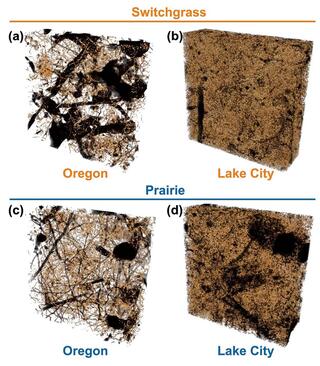Prairie systems facilitate rapid uptake of carbon

Oregon, WI (silt loam) and Lake City, MI (loamy sand) experimental sites. Shown are pores visible at the studied X-ray μCT resolution, i.e., > 18.2 μm Ø. Lightbrown
marks the medium (50–150 μm Ø) pores.
Objective
To assess the associations between pore structure, soil texture, and soil carbon among varieties of monoculture switchgrass and polyculture prairie soils. Past research has suggested a relationship between diversity, the volume of medium pores, and soil organic carbon gains.
Approach
The study assessed soil carbon gains across a variety of marginal soils at experimental sites in Michigan and Wisconsin. Cropping systems were randomly assigned to plots within each of the six unfertilized and untilled sites. Researchers used X-ray computed microtomography to analyze pore structures in harvested soil cores and loose soil surrounding the cores.
Results
Prairie vegetation hosts a greater volume of medium pores, stimulating soil C gains across soil texture and type. The fine roots of prairie vegetation more easily accessed medium pores in sandier soils. Species richness is a factor in higher levels of soil C, but biomass productivity does not determine soil C gains. Additionally, medium pores support higher microbial activity, implying faster processing and protection of new C. However, prairie systems also experienced higher C losses due to CO2 respiration and dissolved organic C.
Impact
Polyculture systems present huge bioenergy potential for lands unsuitable for food production. Polyculture systems’ rapid uptake of carbon implies powerful sequestration potential, which is an important strategy in the effort to mitigate the presence of fossil fuels, which drive climate change.
Jin Ho Lee, Maik Lucas, Andrey K. Guber, Xiufen Li, Alexandra N. Kravchenko, Interactions among soil texture, pore structure, and labile carbon influence soil carbon gains, Geoderma, 439, 116675 (2023). [DOI:10.1016/j.geoderma.2023.116675]